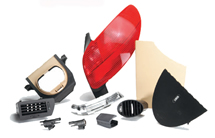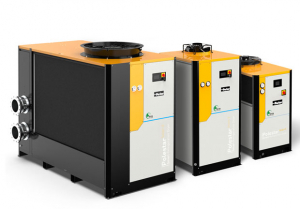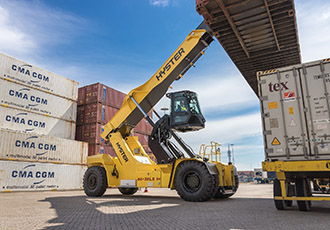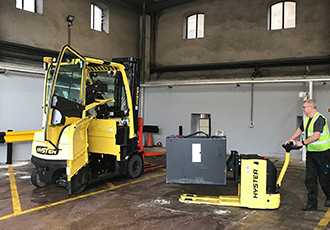Ultrasonic Welding - Design for Successful Production
7th March 2010
Source:
Telsonic UK Limited

For many manufacturers of plastic moulded components, ultrasonic welding has become their preferred joining method as the process is clean, fast and extremely energy efficient. The best and most consistent results however, are always obtained when consideration is given to the materials being used, joint design, preparation and the specific application of the technology, as these factors have a major influence on the process.
In this article, Telsonic’s Martin Frost discusses how thinking ahead about the process and components can assist designers and integrators of the technology to avoid pitfalls and make the most of what is a highly flexible and robust joining technology.
Right First Time!
Reducing the time required to get a product to market is often a key element of today’s manufacturing strategies. Achieving these objectives involves taking a “right first time” approach to minimise the lengthy development stages that can often be associated with a new product. The increasing use of SLA and 3D printed models is a tremendous aid to visualising the shape, size, sections and features of the finished component, giving designers and production engineers a real insight into the production and performance criteria associated with the part. Reducing the design and development time however, means that the product designers have to make carefully considered and informed design inputs more quickly.
Design for assembly
The most effective way of ensuring that the ultrasonic welding process will be consistent and predictable is wherever possible to design for assembly. Focus should be made on the polymers which will be used along with preparation in part geometry and tolerances at the design stage. This will greatly simplify and enhance the reliability of the subsequent assembly and welding process. Considering the potential requirement for specific weld features on the part is essential at the outset of the design process, as this in turn will have an impact not only on the component but the mould tool design also. These are important decisions, that will ultimately have an influence on the production process and part functionality and which should be based on sound advice sought through collaboration with the manufacturer of the ultrasonic technology
Holistic approach
Ultrasonic welding depends upon the response of the materials being joined. Materials such as Polystyrene, ABS and Polycarbonate all respond well to ultrasonic energy. Other materials however, including Polyethylene and tougher grades of Nylon, are more difficult to weld with ultrasonics. Reinforced materials, such as those with fillers, can have a positive or negative impact on the ultrasonic welding process dependant on the fill type and quantity. The best results will always be obtained when the components to be welded are produced from the same material. Dissimilar materials can be joined using ultrasonics providing they are in the same chemically compatible family and have similar melting points. It is also possible to weld completely dissimilar materials using a joint design which will allow one material to be reformed and encapsulate the other mechanically, thus securing it in place.
Next to the selection of materials, part design and in particular joint design hold the key to creating a robust and repeatable weld. Ultrasonic weld specialists and the internet offer plenty of valuable ground rule information on joint designs, indeed Telsonic have their own design recommendation manual. This information should be viewed as a guide only as complex or delicate components require a sensitive approach to welding. As an example, in these instances it is important to establish that the parts to be welded are actually capable of holding up to the forces applied by the process, however small. Other dilemmas faced by the designer include ensuring that a joint can be achieved reliably – at speed and with a sufficiently wide process window. Too narrow a process window will result in repeated machine setting and possibly higher reject rates. The proposed production method – manual or automated – can also have an influence on both the product design and the welding process.
A further consideration may be the presence of other components, especially delicate parts or electronics which may be part of the assembly. At this level it is important to have more than just a basic appreciation of the ultrasonic welding process. Seeking advice from the supplier will ensure that the solution is based upon extensive experience of how best to apply the technology to the task in hand. Examples where this type of collaboration has been successful include the creation of joint designs and part preparation where the ultrasonic energy is focused into the joint efficiently and the weld completed swiftly, without dissipation to other areas of the component or even a change in weld frequency. These principles not only result in a successful weld but eliminate the risk of damage to any internal components.
Where there is to be more than one weld on a given part, both the component and joint design should be reviewed to ensure that energy from multiple weld sequences does not have an adverse effect on any of the previous weld points. Good joint design in delicate components should be mindful of the amount of energy required to achieve the weld. A typical example of the approach would be the use of an “energy director” joint, as opposed to a “shear joint”. This design when combined with application experience, still achieves both strength and a hermetic seal, but with a reduction in the energy required to make the weld of up to 40%. The use of location features, often surrounding the weld joint, make pre-welding assembly more robust by ensuring that the individual parts are positioned repeatably every time, with the added benefit of assisting the welding process.
Mindset – The Joint Is Important!
The importance of dimensional tolerances and component stability must not be overlooked if the welding process is to remain consistent during production. Parts can vary due to inconsistent moulding conditions or poor handling and storage post moulding, whilst parts are cooling. Any resultant inconsistencies within the shape and size of the individual parts due to these factors or inappropriate component tolerances, will be reflected in the results achieved from the welding process.
With the design complete and component parts moulded, the physical parts should then be reviewed carefully at QC level to scrutinise the ultrasonic weld preparation features for size and accuracy. The joint itself should be viewed and respected as a precise collapse of polymer melt, sized and positioned to provide a predictable and process controllable way to achieve fuse strength and not just a token sacrificial bead of plastic.
From planning to production
Having defined materials, joint design, tolerances and moulded a part fit for sustainable and quality production, it is essential to ensure that the welding process is not compromised by the use of inappropriate or underpowered equipment. Attempting to use equipment that is incapable of generating the required amount of ultrasonic power or lacking the control functionality required for the task in hand, will undoubtedly result in continuous adjustments to pressure and amplitude and ultimately guesswork in trying to make the application “fit” the processing capabilities of the machine.
This is especially important for high volume precision components and those used in medical devices or other safety critical applications, where it is essential to produce parts to a consistent specification and quality. In these instances it is essential to ‘invest’ in a supplier specialist with design capability, laboratory development facilities, a broad range of machines and modules, together with the expertise to develop a robust production solution in partnership with the design house, integrator and manufacturer.
Reducing the time required to get a product to market is often a key element of today’s manufacturing strategies. Achieving these objectives involves taking a “right first time” approach to minimise the lengthy development stages that can often be associated with a new product. The increasing use of SLA and 3D printed models is a tremendous aid to visualising the shape, size, sections and features of the finished component, giving designers and production engineers a real insight into the production and performance criteria associated with the part. Reducing the design and development time however, means that the product designers have to make carefully considered and informed design inputs more quickly.
Design for assembly
The most effective way of ensuring that the ultrasonic welding process will be consistent and predictable is wherever possible to design for assembly. Focus should be made on the polymers which will be used along with preparation in part geometry and tolerances at the design stage. This will greatly simplify and enhance the reliability of the subsequent assembly and welding process. Considering the potential requirement for specific weld features on the part is essential at the outset of the design process, as this in turn will have an impact not only on the component but the mould tool design also. These are important decisions, that will ultimately have an influence on the production process and part functionality and which should be based on sound advice sought through collaboration with the manufacturer of the ultrasonic technology
Holistic approach
Ultrasonic welding depends upon the response of the materials being joined. Materials such as Polystyrene, ABS and Polycarbonate all respond well to ultrasonic energy. Other materials however, including Polyethylene and tougher grades of Nylon, are more difficult to weld with ultrasonics. Reinforced materials, such as those with fillers, can have a positive or negative impact on the ultrasonic welding process dependant on the fill type and quantity. The best results will always be obtained when the components to be welded are produced from the same material. Dissimilar materials can be joined using ultrasonics providing they are in the same chemically compatible family and have similar melting points. It is also possible to weld completely dissimilar materials using a joint design which will allow one material to be reformed and encapsulate the other mechanically, thus securing it in place.
Next to the selection of materials, part design and in particular joint design hold the key to creating a robust and repeatable weld. Ultrasonic weld specialists and the internet offer plenty of valuable ground rule information on joint designs, indeed Telsonic have their own design recommendation manual. This information should be viewed as a guide only as complex or delicate components require a sensitive approach to welding. As an example, in these instances it is important to establish that the parts to be welded are actually capable of holding up to the forces applied by the process, however small. Other dilemmas faced by the designer include ensuring that a joint can be achieved reliably – at speed and with a sufficiently wide process window. Too narrow a process window will result in repeated machine setting and possibly higher reject rates. The proposed production method – manual or automated – can also have an influence on both the product design and the welding process.
A further consideration may be the presence of other components, especially delicate parts or electronics which may be part of the assembly. At this level it is important to have more than just a basic appreciation of the ultrasonic welding process. Seeking advice from the supplier will ensure that the solution is based upon extensive experience of how best to apply the technology to the task in hand. Examples where this type of collaboration has been successful include the creation of joint designs and part preparation where the ultrasonic energy is focused into the joint efficiently and the weld completed swiftly, without dissipation to other areas of the component or even a change in weld frequency. These principles not only result in a successful weld but eliminate the risk of damage to any internal components.
Where there is to be more than one weld on a given part, both the component and joint design should be reviewed to ensure that energy from multiple weld sequences does not have an adverse effect on any of the previous weld points. Good joint design in delicate components should be mindful of the amount of energy required to achieve the weld. A typical example of the approach would be the use of an “energy director” joint, as opposed to a “shear joint”. This design when combined with application experience, still achieves both strength and a hermetic seal, but with a reduction in the energy required to make the weld of up to 40%. The use of location features, often surrounding the weld joint, make pre-welding assembly more robust by ensuring that the individual parts are positioned repeatably every time, with the added benefit of assisting the welding process.
Mindset – The Joint Is Important!
The importance of dimensional tolerances and component stability must not be overlooked if the welding process is to remain consistent during production. Parts can vary due to inconsistent moulding conditions or poor handling and storage post moulding, whilst parts are cooling. Any resultant inconsistencies within the shape and size of the individual parts due to these factors or inappropriate component tolerances, will be reflected in the results achieved from the welding process.
With the design complete and component parts moulded, the physical parts should then be reviewed carefully at QC level to scrutinise the ultrasonic weld preparation features for size and accuracy. The joint itself should be viewed and respected as a precise collapse of polymer melt, sized and positioned to provide a predictable and process controllable way to achieve fuse strength and not just a token sacrificial bead of plastic.
From planning to production
Having defined materials, joint design, tolerances and moulded a part fit for sustainable and quality production, it is essential to ensure that the welding process is not compromised by the use of inappropriate or underpowered equipment. Attempting to use equipment that is incapable of generating the required amount of ultrasonic power or lacking the control functionality required for the task in hand, will undoubtedly result in continuous adjustments to pressure and amplitude and ultimately guesswork in trying to make the application “fit” the processing capabilities of the machine.
This is especially important for high volume precision components and those used in medical devices or other safety critical applications, where it is essential to produce parts to a consistent specification and quality. In these instances it is essential to ‘invest’ in a supplier specialist with design capability, laboratory development facilities, a broad range of machines and modules, together with the expertise to develop a robust production solution in partnership with the design house, integrator and manufacturer.
Similar articles
More from Telsonic UK Limited
- Telsonic Showcase New Ultrasonic Packaging Technology at Total Processing & Packaging 2010 11th March 2010
- Telsonic UK Limited to Showcase New Technologies and Concepts at PDM 2010 11th March 2010
- Ultrasonic Welding - Design for Successful Production 7th March 2010
- Telsonic Keep Ultrasonics Safe and Sound 2nd December 2009
Product Centre Updates
2024 World Battery & Energy Storage Industry Expo (WBE)
8th August 2024
China 1st and 2nd Floor, Area A, China Import and Export Fair Complex




.jpg)







Write a comment
No comments